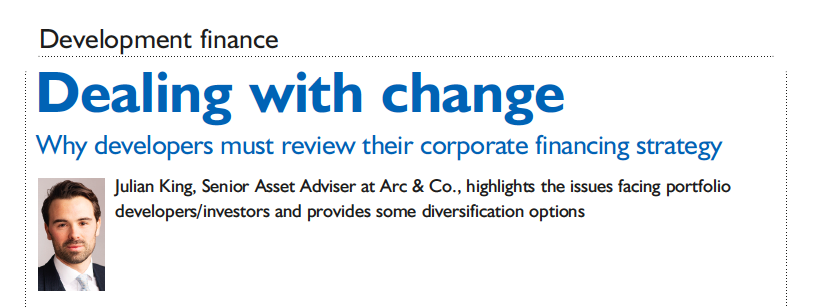
NEWS
ARC & CO. COMPLETE ON TWO DEVELOPMENT LOANS FOR £8.95 MILLION WITH PARAGON BANK
Arc & Co. are pleased to announce the completion of 2 loans totalling £8,950,000 with Adrian Reeves from Paragon Development Finance. Tom Berry from Arc & Co. worked on these deals.
The first case was for the development of 8 units, with this being 4 barn conversions and 4 residential homes. The client instructed Arc & Co. to advise on funding for the scheme, which is located in the rural area of Tempsford in Bedfordshire. Arc & Co. stated: “In an ever changing market, we wanted to expand the client’s exposure to new lenders, which has complemented his long-term corporate financial strategy.” Tom Berry – Asset Finance Advisor at Arc & Co. arranged a £3,100,000 gross loan with Paragon Bank at 64% Loan-To Gross-Development-Value (LTGDV).
The second case was for the purchase and construction of 10 new build homes in Goffs Oak, Hertfordshire and Paragon Bank facilitated a £5,850,000 development loan. The loan completed at the end of March 2020 and was for another new-to-bank client. Securing this size of loan in the current market conditions is a credit to both parties.
Tom Berry – Asset Finance Advisor at Arc & Co. commented : “We are pleased to disclose that that we have completed two loans with Paragon at the end of March. Both cases were introduced as new-to-bank clients. Even in these trying times, Paragon Bank are supporting existing and new-to-bank clients, allowing them to continue developing. I am delighted that both client’s developments could be aided by Paragon Bank.”
Adrian Reeves – From Paragon Development Finance: “Arc & Co. were a pleasure to deal with, as they have been on every occasion. In these difficult times, Tom played a vital part in handling the intricacies of this case with a new-to-bank client.”
Could mezzanine finance be a useful recourse for developers in the coming months?
Humankind is now facing a global crisis. In 2008, the GFC (Global Financial Crisis) severely impacted the world of real estate and the lending market in particular. We now face a different emergency - COVID-19, which is perhaps one of the biggest crises of our generation and will potentially change the face of healthcare, politics and real estate as we know it. As we find ourselves in unchartered waters, will the market for mezzanine finance stand strong? Arc & Co.’s Cameron Hayes, goes on to outline potential solutions.
A Brief History
Since the GFC, mezzanine finance has gained prominence as an alternative debt solution and is characterised by higher leverage potential. Following the collapse of Lehman Brothers in the US and the leveraged finance markets being impacted, lending evolved in response to senior bank debt not providing the same levels of gearing that it did pre-crisis. In the wake of 2008 and with confidence emerging, investors sought new strategies and pursued greater returns in a low yielding market. This began with the emergence of stretched senior products and the growth of preferred equity providers, bridging the gap between bank debt and sponsor equity. Aggressive mezzanine finance providers followed suit, offering a highly leveraged tranche of junior debt, with cost-effective blended returns.
We know that over the last ten years, this has led to mezzanine players having a greater market share with more room in which to compete. Overall mezzanine issuance grew during this period - in terms of capital deployed and the number of new entrants to the market, as market confidence was restored and investors chose to ‘leverage up’. Mezzanine finance quickly became a useful instrument for real estate players whose corporate strategy matured. Investors and developers became less defensive and were encouraged to grow and leverage up to enhance their return on equity.
The Mechanics
Mezzanine finance is a tranche of debt within the capital stack that sits on top of the senior facility and below the equity. It is ‘the jam in a sandwich’ and a slightly more complex form of real estate finance. Mezzanine finance provides a sponsor with the opportunity to increase gearing and borrow more capital, reducing the overall requirement for equity.
The interest rate on mezzanine facilities is typically priced slightly higher than that on senior debt to reflect the level of risk that the lender undertakes. Mezzanine finance is drawn before the senior facility and is repaid later, meaning that the capital is often deployed for a longer period - hence the higher risk profile. The lender will sometimes take an additional form of security (beyond a second-charge) such as a debenture or cross-collateralise the scheme with other projects.
The market for mezzanine finance is well-established. Many investors and developers are familiar with the product and what it is used for. In the face of unknown certainties, mezzanine finance can result in expensive debt and consume profits. Borrowers are often familiar with its use but sometimes, they do not fully understand the adverse consequences of cost-overruns,with contractors going bust and downward markets often too easily forgotten. Being heavily dependent on mezzanine finance can be devastating for not only the development, but also the overall health of a business. If used effectively however, it can allow sponsors to scale-up and acquire larger sites with a limited amount of equity. Sponsors can also achieve higher levels of leverage and more lucrative returns on the equity committed.Mezzanine finance could therefore be a useful recourse for more investors and developers in the coming months.
Contact
Arc & Co. co-host webinar with Medianett and leading names in the real estate industry
Life after Covid-19: mobilising back to a new normal
We recently co-hosted a webinar: ‘Life after Covid-19: mobilising back to a new normal’alongside a number of high profile figures in the finance and real estate industry - featured below.
To listen, please click on the buttons or embedded videos below. The webinar is divided into 3 parts.
Topics discussed during the webinar included:
Whether the industry can hit the ground running when we move into a new normal phase
How the current shift in our way of working will change the way the finance industry works in the future
The effect Covid-19 will have on supply chains — not just in the UK, but sourcing goods and labour internationally
How Covid-19 will impact borrowers’ profits and lenders’ loans and whether this will change the way that contractors source their materials in the future
What lenders’ processes will be once developers fully mobilise their sites after Covid-19
How lenders will assess the original loan terms versus the new predicted project completion date
How a valuer will assess a project - if asked for a new valuation - post Covid-19
Legally, any clauses a lender could invoke on the client
Whether we will we see a shift in how lenders are funded in the future
Whether now is a good time for lenders to take stock of their current loan books and plan sustainably for the future
Top L-R:
Niccolò Barattieri di San Pietro - CEO, Northacre
Simon Collins - Partner in the banking and finance team at Forsters LLP
Dan Smith - CEO, Fortwell Capital
Michael Sharpe-Neal - Divisional Director in the valuation team at Savills LLP
Bottom L-R:
Matthew Yassin - Director, Arc & Co. Structured Finance
Beth Fisher - Editor, Medianett
Edward Horn-Smith, Managing Director, Arc & Co. Structured Finance
Assistance during the Covid-19 pandemic
We understand that volatility as we are experiencing right now generates uncertainty and confusion and your options may not be 100% clear.
Are you experiencing or concerned about one or more of the following areas.
As a Commercial Real Estate Owner:
Hotels – have you had to close your hotel or are you operating with low occupancy rates that will affect your yearly EBITDA?
Student Accommodation – are you experiencing lower take-up occupancy rates for the next academic term?
Retail – have your tenants had to close their stores?
Offices – are your tenants working from home and asking for a payment holiday?
Care homes – have you seen a decrease in your occupancy take-up rates?
As a Real Estate Developer:
Your build program needing to be extended
Land that you want to delay building on
Sales slowing down
As a Buy-to-Let Investor:
Your tenants defaulting
Entering a payment holiday with your lender
Your rights if you own investment property as a limited company
Your eviction rights
Sometimes a chat is all that is needed. Just to get foresight of what you can do if these things happen and take action earlier rather than later, when your options may reduce.
Contact
Arc & Co. launch dedicated CBILS team
“Are you facing project overruns? or in need of working capital/an enhanced cash flow to aid with a number of business-related areas - for example, payroll or projects?”
The government recently announced the launch of the CBILS - a scheme for businesses requiring financial support during the Covid-19 pandemic.
Arc & Co. has now formed a dedicated CBILs team and holds full FCA permissions as well as being a member of the NACFB.
We can provide you with access to all 40 accredited CBILS lenders, with whom we have pre-existing relationships.
We can advise on the following types of loans available through the CBILS:
Term Loans: a business loan which needs to be paid back with interest over an agreed period of time
Asset Finance: this allows businesses to unlock value tied up in their assets - such as equipment, machinery, vehicles and technology
Invoice Finance: lenders use unpaid invoices as security for funding. The amount of funding given is based on the risk criteria of the invoice finance provider
Revolving Credit/ Overdraft: this allows businesses to continue accessing funds after their business account balance falls to below zero
“KEY FACTS ABOUT CBILS
Loans can be offered up to the value of £5 million
The loan term can be for a period of up to 60 months
12 months of the interest due on the loan will be paid for by the government
All of the aforementioned types of finance are available”
Contact
Dealing with change: why developers must review their corporate financing strategy
Arc & Co.’s Julian King has recently written a fascinating article aimed at developers attempting to navigate the uncertain times that Covid-19 has created.
In the article, which can be viewed by clicking here, Julian highlights the issues facing portfolio developers/investors and provides some diversification options.
Here is an excerpt from the article:
At the time of writing this article, the world is experiencing a seismic shift in its ability to function under normal conditions, with all our lives having been changed at a moment’s notice due to the threats posed by the COVID-19 virus.
While the long-term effects of this mayhem on the property market remains an unknown, many construction sites are closed or under pressure to close with the availability of materials becoming more difficult due to builders’ merchants not being open. This pressure on the supply chain will undoubtedly have an effect on the practical completion of projects and has resulted in a delay to the sales process – further compounded by the Government’s instructions to pause property transactions until it is safe to proceed.
Lenders and developers will have to work together to extend debt facilities, so they are in-line with the anticipated construction and sales programme. But what if a developer has already reached practical completion and maybe even completed some sales? What are the other potential options available? The answer to this question depends on the corporate strategy of the developer, which may change from a ‘build to sell’ scenario to a ‘build to hold’ one. Is the developer implementing a strategy for the short, medium or long-term? Perhaps it is a mixture of all three to blend risk and reduce market exposure, which crystallises immediate gain with long-term passive income.
VIEW THE ARTICLE BY CLICKING HERE OR ON THE IMAGE
Contact
Arc & Co.’s 3-Part Blog Series on Development Finance
Introduction
During periods of uncertainty, developers will need to review and potentially alter their overall strategy – especially when it comes to their financial position. Developers should acquire further knowledge on the various financial products on offer to ensure they are in the best possible position and this blog post addresses this to some extent.
Developers will tend to have a formalised process when it comes to securing funding for their projects however, opportunities can still be missed. It is also the case that a general lack of awareness of how debt can actually be structured can lead to missed opportunities.
When developers want to take a higher risk to protect their cashflow and overlap different build programmes, they need different types of finance in order to stretch their gearing. The types of finance used in this scenario include stretched senior finance and mezzanine finance. In this blog post, I first define each type of finance and later in the post, outline how each type can be structured.
Stretched Senior Finance
A stretched senior loan is a product offered by lenders in order to increase their regular senior debt loan. An example of this would be a maxed out senior debt loan at 60% LTGDV and then using a stretched senior debt product to deliver a 70% LTGDV.
Mezzanine Finance
Mezzanine finance cures the same need. Mezzanine is a way of bridging the gap between senior lender finance and the developer’s equity. Mezzanine finance is normally secured by having a second charge over the development in question, whilst the bank or senior lender hold a first charge.
In future blog posts, I will go on to explore additional ways that debt can be structured for development projects.
Part 1a) Funding a development project using stretched senior finance vs. using a combination of senior + mezzanine finance
What are the upsides to simply using stretched senior finance?
For the borrower, stretched senior finance provides speed, convenience and cost savings. The borrower does not have to negotiate separately with two different lenders and saves cost by having just the one set of legal documents.
What are the downsides to using stretched senior finance?
Although dealing with one lender to stretch their offering can be a simpler process, it may not be the best way to achieve the highest return on equity. This is where the role of a financial advisor comes into play, as they can evaluate the benefit of using a stretched senior product - in terms of return on equity, vs. the use of mezzanine finance alongside senior debt, which may prove to be a better option.
Stretched senior products are usually structured on a fixed rate return basis, thus meaning the borrower has to pay a higher interest rate across the entire loan. Whereas senior finance can be structured on a lower variable rate - which depending on the project and the senior loan leverage, can lead to a large saving for the client. The senior loan is combined with mezzanine finance and will be on a fixed interest rate basis.
Part 1b) Funding a development project using senior + mezzanine finance
What are the upsides to using senior + mezzanine finance?
By using senior and mezzanine finance, a blended interest rate can be calculated and this creates an average interest rate between the senior and the mezzanine interest rates. This can give a developer a competitive pricing edge in comparison to using a stretched senior product. There is of course the need to assess the overall total cost of funding which includes the interest rate, arrangement fees and legal fees.
By using mezzanine finance instead of a stretched senior product, the developer is potentially able to achieve a higher gearing level which means a higher level of costs being covered and a smaller amount of equity required upfront.
Mezzanine finance broadens your funding market as we are able to work with many more senior lenders and this gives a developer a lot more lenders to approach in order to secure the right funding package.
What are the downsides to using senior + mezzanine finance?
This route is slightly more complex as there are two different lenders to deal with, as well as legal requirements and costs. This can be a deterrent to this route, but the longer-term added value can make it a lot more profitable.
The perception of mezzanine finance is that it is expensive, but an advisor needs to demonstrate to the client the overall funding cost including senior debt and professional fees . The debt advisor also needs to be competent in advising and negotiating with both the senior and mezzanine finance providers. There is a risk that the two lenders will not be able to negotiate and agree the Inter Credit Deed between them, so it is important for an advisor to address this at the earliest possible stage or even to ask if the two lenders have a pre agreed document they have used on previous cases.
Coming Up: Part 2 – Interest on development finance: fixed rates vs. compounding interest
If you would like to speak to myself or any of the team about a development finance requirement, please contact me by email: tom.berry@arcandco.com or phone: +44 (0) 20 3205 2192
Arc & Co. Arranges £3.75M Senior Funding for Development Site in Winchmore Hill, North London
Jeremy Robinson, Asset Finance Advisor worked with a private developer to help raise funding for his development site in Winchmore Hill, North London.
Asset: Acquisition of the site and a ground-up development of (now) 9 flats
Loan: Senior funding of £3.75 million with 80% of costs covered (including planning gain).
Mezzanine finance of £259,000 (Total facility - £4,006,000)
Gearing: 65% of GDV
Term: 19 months
Rate: The total facility was agreed at a blended rate of 7.85%
For more information about this debt solution, please contact:
Jeremy Robinson, Asset Financial Advisor
Office: +44 (0)20 3205 2199
Mobile: +44 (0)797 673 7552
Email: jeremy@arcandco.com
Arc & Co. Secures £5.7M Senior Development Facility for 8 New Houses
Arc & Co.’s Julian King, Asset Financial Advisor, arranged a development loan for his client who is building 8 new houses in a park-land setting as well as refurbishing a former coach house and vicarage.
Asset: 8 new houses in a park-land setting and a former coach house and vicarage
Loan: Senior development facility of £5.7 million. With an additional slice of mezzanine funding totalling £700,000. Total facility £6.4 million (65% LTGDV/87% LTC)
Gearing: 65% LTGDV/87% LTC
Term: 18 months
Rate: 7.5% p.a
For more information about this debt solution, please contact:
Julian King, Senior Asset Financial Advisor
Office: +44 (0)203 205 2190
Mobile: +44 (0)773 445 7547
Email: julian@arcandco.com
Arc & Co. in the Press - Three Different Articles in One Day!
Avamore Capital and Arc & Co. close development facility for Berkshire scheme - led by Matthew Yassin
Read more: http://bit.ly/2VWVeb3
The Development Finance Market and how it has evolved over the years - a new blog series written by Andrew Robinson Read more: http://bit.ly/2PZFz7o
The Arc & Co. 2020 Lender Predictions LIVE podcast episode - PART 2 with Jon Salisbury Michael Dean James Helmore Alexander Pelopidas Chris Strathon Edward Horn-Smith Julian King and Matthew Yassin
Read more: https://bit.ly/2IwLQDh
#lender #developmentfinance #money #investment #avamorecapital #ortussecuredfinance #paragondevelopmentfinance #bridging #development #realestate #property
Arc & Co’s Director of Aviation Finance, Gary Crichlow, Discusses Costs and Financial Considerations of Aircraft Ownership
In the first of two articles for EVA Magazine, Arc & Co’s Director of Aviation Finance, Gary Crichlow, takes a look at the costs and financial considerations of aircraft ownership. Key industry experts also share their thoughts about managing the costs of ownership - saving you money, making your money work harder, and avoiding expensive mistakes.
Key industry experts that contributed to this article include:
Nick Houseman, co-owner and board member of operator Elit’avia
Nel Stubbs, Vice President at Conklin & de Decker
Colin Brickman, Managing Partner at Switzerland-based aviation technical advisory firm CAMO4jets
Lou Seno, Chairman Emeritus and Special Advisor at Jet Support Services Inc (JSSI)
Côme Charron, European Sales Director at aircraft broker Guardian Jet













































